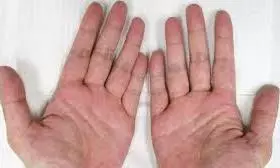
What your hands might be saying about your liver: early signs of fatty liver disease
text_fieldsFatty liver disease is often described as a silent condition. But, early warning signs may actually appear right on your hands.
Experts say recognising these subtle symptoms could help detect the problem before it progresses.
Medical professionals are drawing attention to how changes in the skin, particularly on the hands, can be linked to underlying liver dysfunction.
Fatty liver disease, especially the non-alcoholic kind (NAFLD), is increasingly affecting individuals across all age groups, regardless of alcohol consumption. And in many cases, the hands are among the first areas to reflect this silent condition.
Some key hand-related symptoms that may point to early liver trouble include:
1) Palmar erythema: A noticeable redness on the palms, which occurs due to changes in circulation and hormonal imbalance as liver function declines.
2) Persistent itching: Especially on the hands, caused by the buildup of bile salts in the bloodstream when the liver struggles to filter waste.
3) Dry or fragile skin: A result of vitamin and nutrient deficiencies that often accompany chronic liver issues.
4) Spider-like blood vessels (spider angiomas): Small, web-shaped blood vessels that may appear on the hands, arms, or face—often linked to elevated estrogen levels.
5) Clubbing of the fingers: A condition where the fingertips become bulbous and the nails curve over, commonly associated with oxygen deficiency and long-standing systemic issues.
Though these symptoms might not immediately seem connected to liver function, they can reflect the cascading effects of an overloaded liver.
Fatty liver disease occurs when excess fat accumulates in the liver cells, impairing its ability to process hormones, filter toxins, and break down fats effectively. In NAFLD, which is not related to alcohol use, this fat build-up is closely linked to metabolic disorders such as obesity, insulin resistance, and high cholesterol.
As the liver's workload increases, its capacity to regulate estrogen levels, process bile, and maintain healthy blood flow is compromised - leading to symptoms that manifest in the skin and circulatory system.
Spotting these signs doesn't mean something is definitively wrong, but it is a reason to get checked. A basic health evaluation that includes liver function tests and an ultrasound scan can help determine whether fat accumulation is present and how advanced it is.
The good news is that lifestyle changes can reverse early-stage fatty liver disease. Doctors recommend:
- Losing weight gradually – even a 5–10% reduction can help
- Eating a balanced diet rich in fibre, lean proteins, healthy fats, and whole foods
- Limiting sugar and processed food intake
- Avoiding alcohol entirely
- Exercising regularly, particularly aerobic activities and strength training
- Staying hydrated and managing cholesterol levels
While anyone can develop fatty liver disease, it’s particularly common among people who are overweight, have type 2 diabetes, or suffer from high cholesterol or metabolic syndrome.
Current data suggests that a majority of cases seen in screenings are non-alcoholic in origin, driven largely by lifestyle-related factors.
Early intervention is crucial. Left unmanaged, fatty liver disease can progress to more severe complications, including liver scarring (fibrosis), cirrhosis, and even liver cancer.












